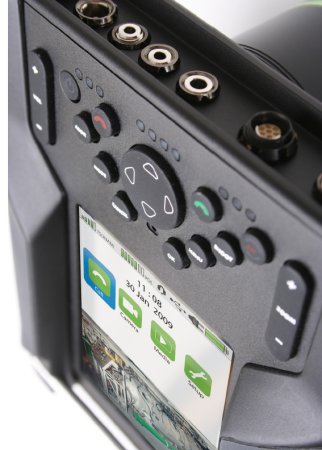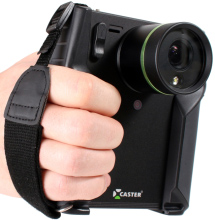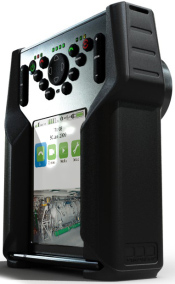Linux videophone does HD over WiFi
Mar 3, 2009 — by Eric Brown — from the LinuxDevices Archive — 5 views [Updated: Mar. 4, 2009] — Stavanger, Norway-based Pixavi has used embedded Linux to build what it claims is the first wireless videoconferencing camera capable of 720p HD conferencing. The ruggedized, battery-powered Xcaster offers CD-quality audio, 5Mpix stills, collaboration tools, Bluetooth, and 802.11n WiFi.
[Updated: Mar. 4, 2009] — Stavanger, Norway-based Pixavi has used embedded Linux to build what it claims is the first wireless videoconferencing camera capable of 720p HD conferencing. The ruggedized, battery-powered Xcaster offers CD-quality audio, 5Mpix stills, collaboration tools, Bluetooth, and 802.11n WiFi.
(Click for larger view of the Xcaster)
The Xcaster is primarily aimed at industrial environments that require mobile videoconferencing and rugged operation, says the company. The aluminum-shielded product is IP68-rated for waterproofing, and offers impact resistence to up to two-meter drops onto concrete, claims Pixavi. Specific applications include manufacturing, oil, gas, and chemical industries, building and construction, telemedicine, surveillance, shipyards, mining, firefighting, law enforcement, the military, and journalism. (We always knew our job was tough.)

Xcaster display and controls
(Click to enlarge)
The Xcaster appears to be the heir to Pixavi's previous generation of “VisiWear” video-conferencing products, which were first introduced in 1999. The device's processor was not disclosed, but it runs a Linux distribution based on “the latest Linux kernel,” says the company.
The camera is said to ship with 16GB of flash for storage, and offers Ethernet, USB 2.0, Bluetooth, and audio/video I/O. Measuring 5.1 x 2.3 x 1.2 inches, the Xcaster is equipped with a 480 x 640 touchscreen display with backlighting, says Pixavi.


Xcaster from the front and top
(Click on either to enlarge)
The XCaster is available in two models, differentiated by WiFi type. The ST 5000g “low power” model uses 802.11g WiFi (100-meter range), and is said to support up to 10 simultaneous live HD streams. It provides five hours of active battery life, according to the company's figures.
The ST 5000n “high power” model provides higher-bandwidth, wider-range 802.11n WiFi (300-meter range), and up to 50 simultaneous live HD streams. However, claimed battery life shrinks to 2.5 hours (still enough for tortuously long meetings, if you ask us).
Meanwhile, two more “EX Zone” models touted as “intrinsically safe and explosion proof” will ship at a later date, says the company. (Those must be the models designed for journalists.)
Both currently shipping models offer a camera that provides 5.1Mpix still images and 25fps video at 720p (1280×720), 4CIF, or CIF resolution, says Pixavi. The codecs in use are H.263 and H.264, and H.323, SIP, and the collaboration-specific H.239 are used for signaling. With the help of an integrated gyroscopic MEMS sensor located above the lens, and a laser pointer, users can do collaborative laser drawing over simultaneous real-time HD video and audio transmissions, says the company.
 Xcaster rear view (Click to enlarge) |
Specifications listed for the Xcaster include
- Processor — undisclosed
- Flash — 16GB onboard flash (for up to 48 hours 4CIF video)
- Display — 480 x 640 TFT touchscreen; 200-cd brightness; dual 271×480 video-mode canvases; transflective/LED backlighting
- Networking — 1 x Ethernet port (RJ-45)
- WiFi — 802.11n (ST 5000n with dual-band 2.4- or 5Ghz radios) or 802.11g (ST 5000g); internal and external antennas
- Bluetooth — Bluetooth 2.0
- USB — 1 x USB 2.0 port
- A/V I/O — HD/SD video I/O
- Video — H.263 and H.264 codecs for 720P (1280×720) HD, 4CIF, CIF, all at 25fps
- Video-conferencing support — SIP, H.323, H.239 (collaboration)
- Camera:
- 5.1-Mpixel autofocus camera
- 4 x optical plus 12X lossless digital zoom
- Image stabilization
- CMOS 1/2.5-inch
- Signal noise ratio — 50db
- Dynamic range — 70db
- Rolling shutter
- Audio:
- 16-bit stereo recording
- Digital omni-directional microphone
- Hands-free support
- Bluetooth headset support
- Stereo speakers
- AAC LC/LD CD quality
- Echo cancellation
- Headset connection
- Line in/out
- Audio formats — G.711, G.722, G722.1, G.728, AAC-LC/LD
- Networking features:
- Diffserv QoS
- UPnP
- Firewall traversal technology
- STUN server support
- ISMA 2.0 streaming
- Other features — laser pointer; power and status LEDs; tripod mount; stylus; IR port
- Ruggedization — IP65 splash proof; 4 joule impact proof; shock proof
- Power — DC input/charging; Power over Ethernet (PoE) support
- Battery life — 2.5 hours (ST 5000n) or 5 hours (ST 5000g) operating life; 200 hours standby
- Dimensions — 5.1 x 2.3 x 1.2 inches (130 x 110 x 30mm)
- Weight — 1.1 lbs (500 gr) for ST 5000g; 1.8 lbs (800 gr) for ST 5000n
- Operating temperature — 14 to 95 deg. F (-10 to 35 deg. C); extended temp version to ship later
- Operating system — Linux
The Xcaster is billed as a do-it-yourself IP webcam, enabling ad hoc set up of sessions, and the company claims to have tested interoperability with HD video-conferencing endpoints from Tandberg, Polycom, Lifesize, and Radvision. If need be, however, Pixavi's Go Live service is available to help manage connections between the Xcaster and other video-conferencing systems, as well providing networked multimedia storage. A new Go Live 2.0 version is in the works, touted for its secure, encrypted communication and Web 2.0 technology, says the company.
Pixavi sells a wide range of wireless infrastructure equipment, WiFi and WiMAX devices, and antenna products, as well as location tracking devices, and wireless video surveillance technology, it says.
Stated Pixavi CEO, Christian Rokseth, “Almost 50 percent of the video conferencing endpoints and VC enabled computers are now HD capable. This growing trend perfectly matches our target of developing an HD collaboration camera.”
Availability
The Xcaster ST5000 will be available in May 2009, priced at $8,000. More information may be found here. Pixavi also offers extra-cost services including hosted and managed services like Go Live 2.0, SIP services, and hosted video-conferencing software, says the company.
This article was originally published on LinuxDevices.com and has been donated to the open source community by QuinStreet Inc. Please visit LinuxToday.com for up-to-date news and articles about Linux and open source.